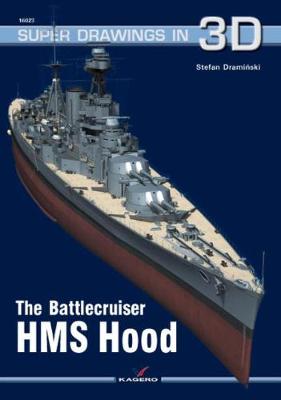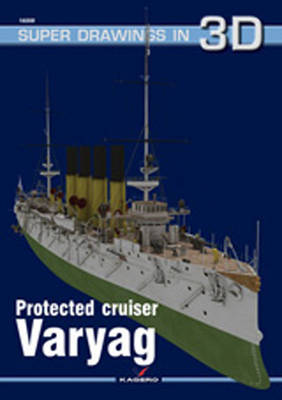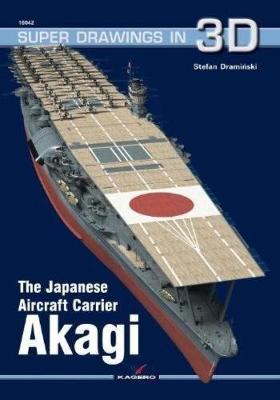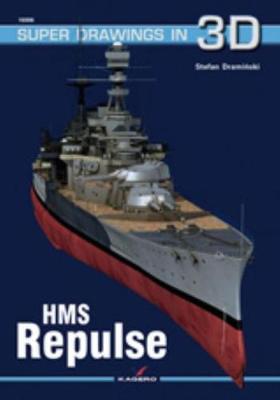Super Drawings in 3D
6 total works
The text part of this book describes history of the ship's construction and service. This is accompanied by more than 100 color illustrations showing HMS Hood's appearance in her final configuration, during battle of the Denmark Strait, 24 May 1941. Elements that are shown in detail include superstructures, armament, boats, equipments, rig, etc. Blueprints in 1:350, 1:200, 1:100 and 1:50 scales (general views and details) are included on a separate sheet. The publication is a great reference for building a detailed model of HMS Hood.
In-depth look the Imperial Russian cruiser Varyag, famed for her crew's heroic defiance during the Russo-Japanese War, including design and construction notes, technical characteristics, data tables, machinery, propulsion, armament and operational history.
Excellent visual guide to the ship from all aspects, looking at colour schemes, ship's boats, weapons, masts and fittings. Amply illustrated with 82 excellent computer generated colour graphic images, this volume also includes two double-sided bonus pull-outs: a colour poster and scale plans. The plans represent the ship's 1901 configuration, with bow, stern, port and starboard profiles in both 1/350 and 1/700 scales, along with 1/100 scale gun and 1/200 scale boat drawings, plus a detailed oblique view.
About the Series
This brand-new series focuses on the construction of famous ships- battleships, carriers, cruisers, and submarines. With ground-breaking 3D imagery, each corner, angle, and dimension of the ship is viewable. With various close-up views, and each 3D image based on actual technical scale drawings and photographs, this makes an exceptional reference tool. Information on the design, development and combat history of each vessel is also included, as well as numerous photographs and 1/350th scale drawings.
Excellent visual guide to the ship from all aspects, looking at colour schemes, ship's boats, weapons, masts and fittings. Amply illustrated with 82 excellent computer generated colour graphic images, this volume also includes two double-sided bonus pull-outs: a colour poster and scale plans. The plans represent the ship's 1901 configuration, with bow, stern, port and starboard profiles in both 1/350 and 1/700 scales, along with 1/100 scale gun and 1/200 scale boat drawings, plus a detailed oblique view.
About the Series
This brand-new series focuses on the construction of famous ships- battleships, carriers, cruisers, and submarines. With ground-breaking 3D imagery, each corner, angle, and dimension of the ship is viewable. With various close-up views, and each 3D image based on actual technical scale drawings and photographs, this makes an exceptional reference tool. Information on the design, development and combat history of each vessel is also included, as well as numerous photographs and 1/350th scale drawings.
The vessel, which was to become the most famous Japanese aircraft carrier and the symbol of the might of the Imperial Japanese Navy
aviation was initially built as a battlecruiser. Only as the result of the resolutions of the Washington Naval Treaty the Akagi ("Red Castle", the name of a Japanese mountain) was completed as an aircraft carrier. During the first half-year of the war in the Pacific she was the flagship of the carrier strike group marching from one victory to another. The reversal took place during the battle of Midway, when a hit by a single bomb in a fatal moment sealed her fate.
aviation was initially built as a battlecruiser. Only as the result of the resolutions of the Washington Naval Treaty the Akagi ("Red Castle", the name of a Japanese mountain) was completed as an aircraft carrier. During the first half-year of the war in the Pacific she was the flagship of the carrier strike group marching from one victory to another. The reversal took place during the battle of Midway, when a hit by a single bomb in a fatal moment sealed her fate.
HMS Repulse was a Renown-class battlecruiser, the second to last battlecruiser built by John Brown and Company, Clydebank, Scotland, for the Royal Navy. She was launched in 1916, too late to take part in the Battle of Jutland, though still in time to take a crucial part in the First World War. In September 1916, she joined the Grand Fleet as flagship of the 1st Battlecruiser Squadron.
After the outbreak of the Second World War in 1939, Repulse operated in various hunting groups that were formed to hunt down German commerce raiders. Shortly after the outbreak of war in the Pacific on 8 December 1941, Repulse left Singapore in company with HMS Prince of Wales, and four destroyers, to try and intercept Japanese invasion convoys heading towards Malaya. Found and involved in an air attack by the Japanese, Repulse was fatally hit and rolled over and sank at 12:23, 10 December 1941.
This modelling guide provides a lavishly illustrated history of this impressive warship with numerous close-up and panoramic shots based on actual technical drawings.
About the Series
This brand-new series focuses on the construction of famous ships– battleships, carriers, cruisers, and submarines. With ground-breaking 3D imagery, each corner, angle, and dimension of the ship is viewable. With various close-up views, and each 3D image based on actual technical scale drawings and photographs, this is an exceptional reference tool. Information on the design, development and combat history of each vessel is also included, as well as numerous photographs and 1/350th scale drawings.
After the outbreak of the Second World War in 1939, Repulse operated in various hunting groups that were formed to hunt down German commerce raiders. Shortly after the outbreak of war in the Pacific on 8 December 1941, Repulse left Singapore in company with HMS Prince of Wales, and four destroyers, to try and intercept Japanese invasion convoys heading towards Malaya. Found and involved in an air attack by the Japanese, Repulse was fatally hit and rolled over and sank at 12:23, 10 December 1941.
This modelling guide provides a lavishly illustrated history of this impressive warship with numerous close-up and panoramic shots based on actual technical drawings.
About the Series
This brand-new series focuses on the construction of famous ships– battleships, carriers, cruisers, and submarines. With ground-breaking 3D imagery, each corner, angle, and dimension of the ship is viewable. With various close-up views, and each 3D image based on actual technical scale drawings and photographs, this is an exceptional reference tool. Information on the design, development and combat history of each vessel is also included, as well as numerous photographs and 1/350th scale drawings.
The HMS Queen Mary was completed on 4 September 1913 by the British Royal Navy and was the last battlecruiser to be completed before the onset of World War I. She was the first battlecruiser to place her officers' quarters in their traditional location, the stern of the ship, rather than closer to their action stations amidships. In addition she was the first to mount a sternwalk.
At load she displaced 27,200 tons and was marginally larger than her Lion class predecessors. The only one of her kind, the HMS Queen Mary joined the 1st Battlecruiser Squadron under the command of Rear Admiral Beatty. She was sunk at the Battle of Jutland on 31 May, 1916.
Today, she lies intact and upside-down on the bottom of the North Sea, and as the final resting place of 1,257 officers and men, has been declared a protected place under the Protection of Military Remains Act 1986.
About the Series
This series focuses on the construction of famous ships– battleships, carriers, cruisers, and submarines. With ground-breaking 3D imagery, each corner, angle, and dimension of the ship is viewable. With various close-up views, and each 3D image based on actual technical scale drawings and photographs, this makes an exceptional reference tool. Information on the design, development and combat history of each vessel is also included.
At load she displaced 27,200 tons and was marginally larger than her Lion class predecessors. The only one of her kind, the HMS Queen Mary joined the 1st Battlecruiser Squadron under the command of Rear Admiral Beatty. She was sunk at the Battle of Jutland on 31 May, 1916.
Today, she lies intact and upside-down on the bottom of the North Sea, and as the final resting place of 1,257 officers and men, has been declared a protected place under the Protection of Military Remains Act 1986.
About the Series
This series focuses on the construction of famous ships– battleships, carriers, cruisers, and submarines. With ground-breaking 3D imagery, each corner, angle, and dimension of the ship is viewable. With various close-up views, and each 3D image based on actual technical scale drawings and photographs, this makes an exceptional reference tool. Information on the design, development and combat history of each vessel is also included.
Launched in 1940, North Carolina was the first U.S. newly built battleship to have taken part in the war in the Pacific. During her busy combat career she demonstrated that battleships could perform very well indeed in their new role as escorts for fleet aircraft carriers and weapon platforms providing fire support for ground troops. Having earned no fewer than 15 Battle Stars during her wartime service, North Carolina was the most highly decorated US Navy battleship of World War II. After decommissioning, she escaped the chopping block and is preserved to this day as a floating museum





